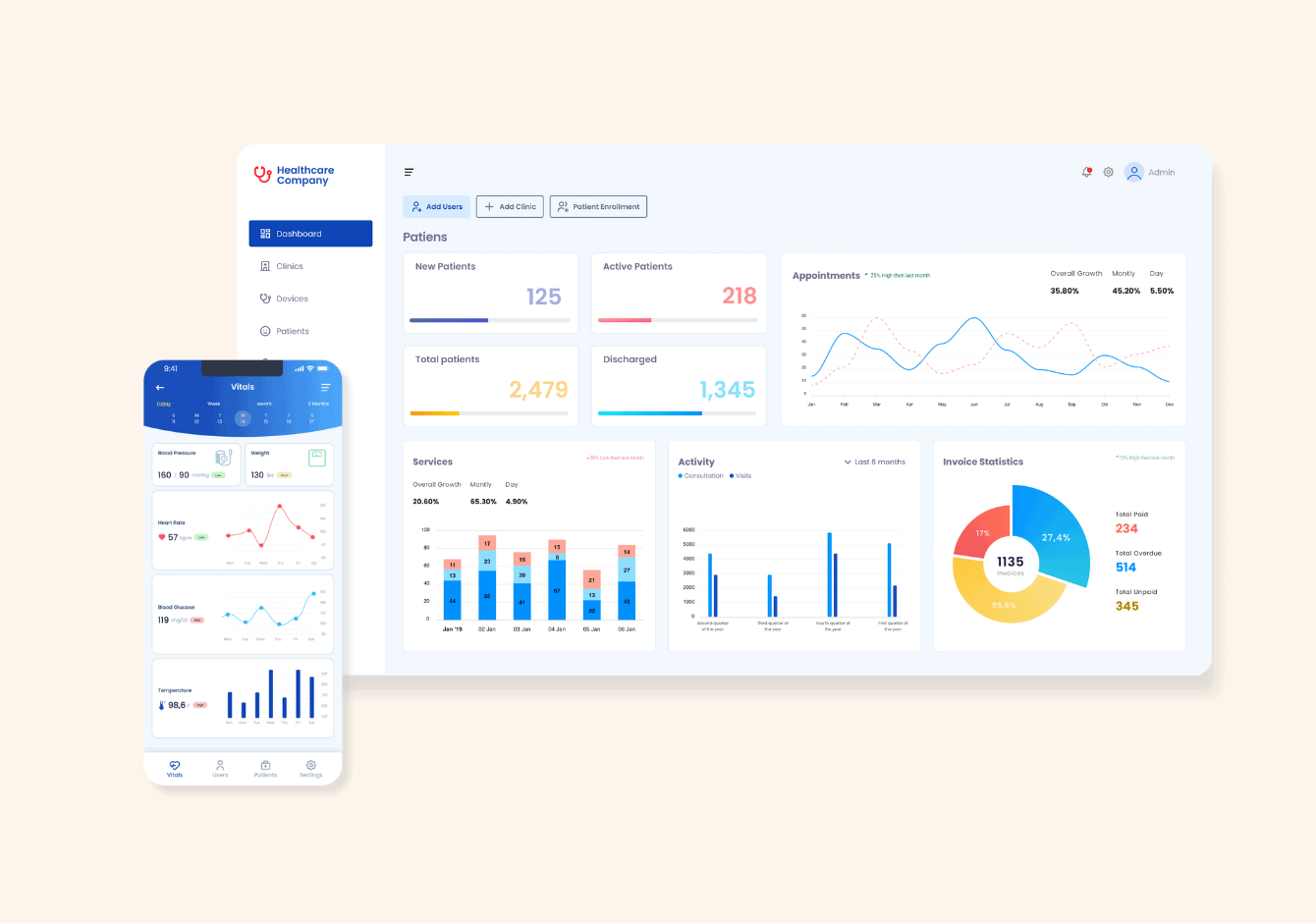Determining whether telehealth reduces costs is a complex question with many conflicting views, as telemedicine implementation requires a long-term investment that pays off gradually over the years. Even though tracking the actual ROI and impact is challenging, the benefits of telehealth are tangible right after its adoption. It reduces patient costs and brings many advantages that indirectly optimize expenses, such as serving more patients in less time.
Besides, telehealth services receive strong governmental support in many countries, including the US. In the last 5 years, 18 states passed laws to add audio-only telehealth coverage to health plans. Moreover, since 2020, Medicare has started covering more telehealth services, some of which at a lower rate.
What does it have to do with the cost?
In fact, a lot.
These initiatives stimulate the broader provision of telehealth and its accessibility for patients. It becomes a cost-effective solution for physicians and providers to treat patients and arrange their workflows. Read more about telemedicine costs and benefits below.
Healthcare Expenses Overview and Why are Telehealth Cost Savings So Important
Telehealth software development is showing consistent, year-over-year growth. Think of it, in 2027, it’s expected to reach $559,52 billion in the USA. As federal funding for Medicare and Medicaid increases, new opportunities for healthcare businesses also emerge. However, there is another side to it.
The USA is a leader among the countries in terms of healthcare spending per person. In 2022, healthcare spending in the US almost reached $4.5 trillion, averaging $13,493 per person. This accounted for 17.3% of the country’s GDP. By comparison, other wealthy nations spend significantly less per capita on healthcare. For instance, health expenditures per person in comparable high-income countries averaged about $6,651, making US spending more than twice as high as the average of these countries.
With the increasing healthcare spending globally, telehealth cost savings are one of the ways to optimize expenses, easing the financial pressure on national budgets and people. Multiple studies show that telemedicine solutions reduce expenses for patients and healthcare providers, including:
- Telehealth for cancer care at a National Cancer Institute–Designated Comprehensive Cancer Center saved an estimated $147.4 to $186.1 per visit, totaling over $1.6 million in lost productivity savings from April 2020 to June 2021.
- In Houston, telehealth-enabled EMS intervention saved $928,000 annually and reduced costs by $2468 per emergency department visit. The average telehealth patient cost was $167, which was $103 less than traditional EMS.
- Telemedicine reduced ICU stays by 30%, resulting in fewer doctors needed, more space in ICUs, fewer hospital stays, and significantly reduced healthcare costs.
- Remote monitoring for high-risk pregnancies in Belgium reduced hospital admission costs by $233,958 annually, with initial investments of $15,409.17.
In summary, telehealth significantly reduces healthcare costs by decreasing travel expenses, minimizing hospital admissions, and shortening ICU stays. It saves money for both patients and healthcare providers, making healthcare more efficient and accessible.
How Does Telehealth Reduce Costs: 6 Common Ways
Low-income patients struggle to access healthcare. The 2019 National Health Interview Survey found that many people delayed or did not receive medical care (8.5%), dental care (14.7%), or prescription medication (5.6%) due to cost. This is where the telemedicine industry steps in. So, how does telemedicine reduce costs?
Cuts Travel-Related Costs
Using telemedicine platform development can optimize and prioritize emergency cases, cut transport and clinician travel costs, or avoid those if the in-person visit isn’t needed.
Lower travel costs are not only about benefiting patients but also about how much an at-home doctor’s visit can cost the provider. In-home visits and emergency responses involve significant travel costs, which can be pretty high. These visits require clinicians to spend considerable time traveling, reducing the number of patients they can see daily and lowering overall productivity. Additionally, the costs associated with fuel, vehicle maintenance, and potential overtime pay for staff traveling to remote locations further increase the financial burden.
Enables Home-based Triage
Home-based triage involves remote consultations with primary care specialists and nurses to assess the severity of a patient’s condition. This often eliminates the need for in-person visits, reducing unnecessary ER trips and associated costs. It saves patient travel expenses and optimizes resource use for healthcare providers, ensuring emergency services are available in critical cases. Remote appointments may also speed up the ambulance visit for patients in critical condition.
Telehealth Optimizes Healthcare Costs Associated with ER
Regular doctor’s appointments telehealth enables, among other things, can substitute around ⅔ of emergency room visits – and cost patients 12 times less than EDs. 71% of ambulance providers don’t accept insurance of any kind, which is why people may spend over $450 to be taken to the ER for no critical reason. Of course, the patients’ wallets will benefit the most from remote evaluation. However, it’s also a surefire way for the providers to manage their staff and in-crisis patients more effectively.
Reduces Readmission Rates (and Costs)
Implementing telehealth can lower the number of patients returning to the clinic after discharge if they undergo regular diagnostic and check-ups. The thing is, not every check-up should take place in the hospital – some require consultations that can be done over a phone or videoconferencing. This approach reduces costs by cutting unnecessary hospital visits and readmissions, saving money on transportation and hospital resources. Telemonitoring also enables early detection of health issues, which translates into more timely interventions that prevent complications, further decreasing healthcare expenses and improving patient outcomes.
Allows Remote Monitoring
Whether a patient has an implanted device that requires constant monitoring, just got discharged from the hospital after surgery, or has a high-risk pregnancy, monitoring their conditions is important and must be continuous.
Some monitoring practices are possible online, demonstrating that home telehealth effectively reduces healthcare costs. For instance, telemonitoring for patients with heart failure has shown significant cost savings. The TEC4Home pilot study in Canada showed a substantial reduction in costs associated with length of stay during hospital admissions, saving CAD 1,631 per patient from the health system perspective and CAD 1,303 per patient from a partial societal perspective.
By enabling continuous remote monitoring, telehealth reduces the need for frequent hospital visits and readmissions, which are costly for patients and healthcare systems. This not only improves patient outcomes but also reduces overall healthcare expenses.
Read more about the value of telemonitoring for patients with heart failure
Enables More Appointments and Better Planning
In many cases, the number of appointments the provider can offer depends on the facility’s capacity. However, not every consultation or appointment presupposes screenings or tests the very first time – the only thing patients need is a qualified professional who will listen to their concerns and advise what to do. Telemedicine solutions and technologies will allow you to multiply the number of primary appointments. Unlike traditional in-person visits, telemedicine eliminates the need for travel, allowing doctors to see more patients in a day. Additionally, it facilitates quicker follow-ups and shorter consultation times, further enhancing appointment capacity.
As you can see, telemedicine significantly improves access to care, enabling prompt medical attention and reducing delays in diagnosis and treatment, especially for rural residents and those with chronic conditions. Home-based triage and remote monitoring facilitate early detection of health issues, allowing for timely interventions that prevent complications and reduce hospital admissions.
How Telehealth Improves Health Outcomes
Around 86% of Americans found telehealth convenient, while 31% appreciated the cost savings associated with virtual visits. Additionally, almost 52% of respondents reported they can visit physicians online more often thanks to telehealth.
Beyond these advantages, telehealth improves treatment outcomes in several other ways.
Effective Healthcare Provision to Rural Residents
Integrating EHR and telehealth solutions helps patients stay connected with healthcare providers regardless of their location. Rural areas typically lack healthcare facilities and specialists, which leads to delays in diagnosis and treatment. Telehealth video conferencing overcomes this by allowing remote access to medical consultations, follow-ups, and test interpretations, ensuring patients get timely care. This is crucial for chronic conditions, where regular monitoring and prompt interventions can prevent complications and reduce hospital admissions.
Additionally, telehealth reduces costs for rural patients by eliminating travel expenses and reducing time away from work. It gives patients more control over their health by allowing them to schedule appointments easily, access medical records online, and communicate directly with healthcare providers.
Fewer Barriers to Treatment
Starting a telemedicine practice can help many people manage common healthcare barriers like the unavailability of those who accept their insurance, the need to take time off, the inability to travel long distances, and so on. Telemedicine eliminates most of these barriers, as sometimes the only thing patients need is their smartphone/computer and some 30 minutes. The result? More consistent care and better health outcomes.
Reduced Exposure to Diseases
With the medical crisis caused by COVID-19, fewer people are willing to go to the hospital even when needed. Thanks to telehealth technologies, providers can manage the patient’ flow and admit to hospitals only those who need inpatient care. Clinics and offices will have fewer people on their premises, thus eliminating the risk of spreading diseases.
Maintained Independence
Access to telehealth is crucial for older adults and those with limited mobility, as it enables them to receive necessary healthcare independently, enhancing their confidence and well-being. A recent research found that 55% of clinicians believe telehealth improves healthcare for older adults by enhancing stakeholder engagement. Besides, 41% of clinicians note that it eliminates the need for older adults to travel to appointments, lowering costs and stress on caregivers.
Easy and Comprehensive Treatment Planning
Telehealth programs and platforms often have a familiar look and touch, which helps patients stay actively involved in their treatment planning and follow-up procedures. User-friendly telehealth apps allow patients to access their medical records, schedule appointments, and communicate with healthcare providers. They also align the work of healthcare specialists since all information is collected in one place.
This approach enhances patient engagement and facilitates coordinated care among healthcare specialists, improving health outcomes and patient satisfaction.
Improved Medication Adherence
Following the treatment plan and taking medication is necessary for positive dynamics. The reality is that patients often forget to do it, which may affect the outcome. Besides, many patients skip medications because of high costs. Data from the CDC indicates that in 2021, 8.2% of adults aged 18–64 did not take their medications as prescribed due to various reasons, including cost and forgetfulness. The telehealth apps and reminders, refill notifications, and educational information delivered online can increase the likelihood of taking the prescribed medication in time.
Empeek for Telehealth Development and Implementation
At Empeek, we develop custom telehealth software solutions that enhance the quality, efficiency, and accessibility of healthcare services. We have a proven track record of developing custom telehealth solutions tailored to client needs, significantly improving healthcare delivery and patient outcomes. Here are some of our projects:
- Empeek designed and implemented an RPM portal that leverages cellular and Wi-Fi technology to collect and securely transmit health data from patients’ homes to healthcare providers. Real-time data collection enables continuous monitoring and proactive health management. The RPM system facilitates quicker patient care decisions by providing healthcare specialists with timely data, significantly reduces emergency room visits and hospital readmissions, and improves the quality of life for patients through continuous monitoring and early intervention.

- Another project is an advanced AI system for real-time heart monitoring that addresses inefficiencies and scalability issues in traditional monitoring methods. This system leverages big data and machine learning algorithms to classify heart issues with minimal human interaction. The platform was designed to eliminate slow and error-prone human decision-making.
Ready to enhance your healthcare practice with a custom telehealth solution? Schedule a call with our team to discuss your requirements and get a detailed budget estimate.
Final Thoughts
So, how does telehealth reduce costs? Mainly, it helps by minimizing expenses related to travel, emergency room visits, and hospital readmissions. It also considerably optimizes the work of healthcare specialists through convenient appointment scheduling, remote health tracking, and automated record management.
Besides cost-efficiency, telehealth addresses barriers such as provider availability, improving treatment adherence and reducing disease exposure. Telehealth platforms also enhance patient engagement through easy access to medical records and direct provider communication, promoting comprehensive and coordinated care.








